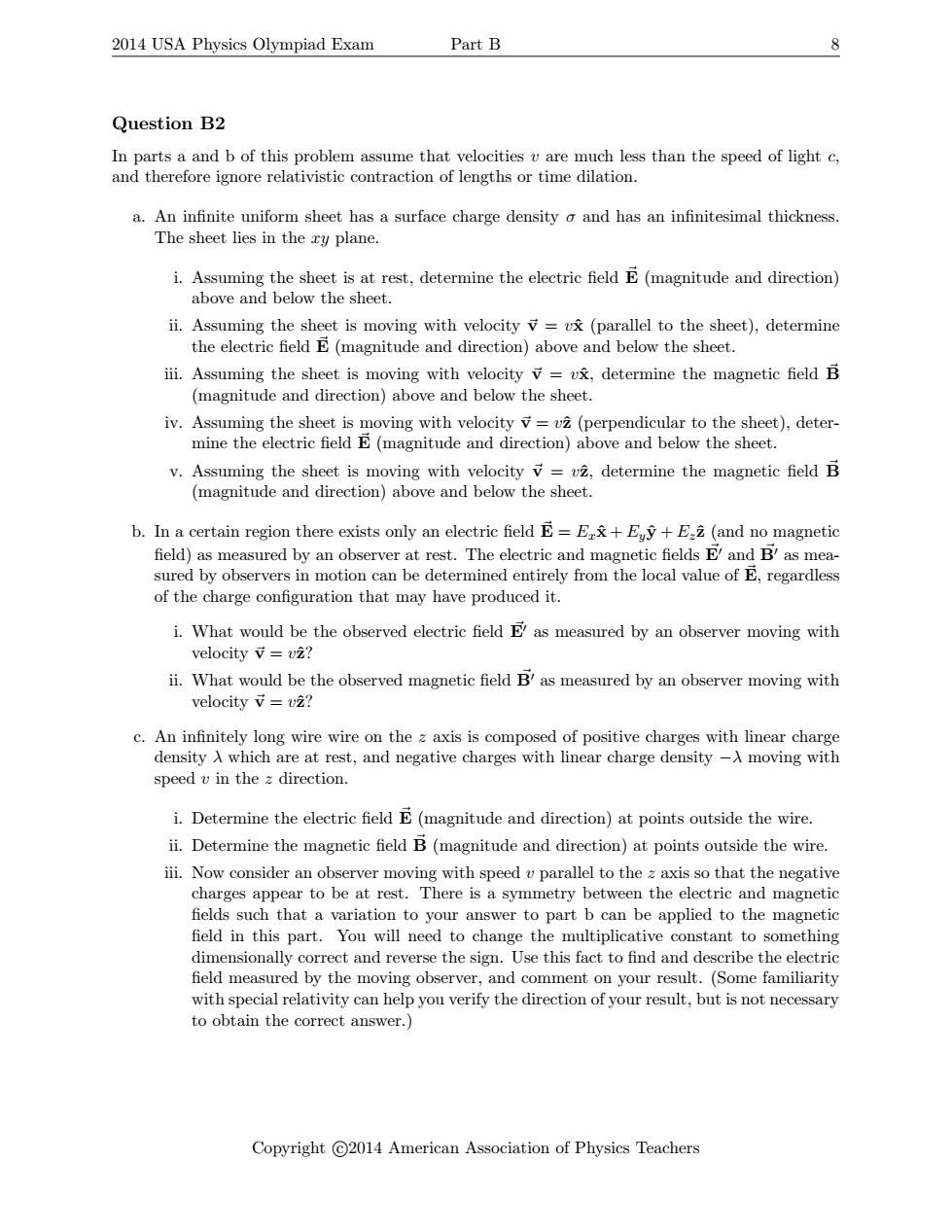正在加载图片...

2014 USA Physics Olympiad Exam Part B 8 Question B2 In parts a and b of this problem assume that velocities v are much less than the speed of light c, and therefore ignore relativistic contraction of lengths or time dilation. a.An infinite uniform sheet has a surface charge density o and has an infinitesimal thickness. The sheet lies in the xy plane. i.Assuming the sheet is at rest,determine the electric field E(magnitude and direction) above and below the sheet. ii.Assuming the sheet is moving with velocity =vx(parallel to the sheet),determine the electric field E(magnitude and direction)above and below the sheet. iii.Assuming the sheet is moving with velocity v=vx,determine the magnetic field B (magnitude and direction)above and below the sheet. iv.Assuming the sheet is moving with velocity v=v2(perpendicular to the sheet),deter- mine the electric field E(magnitude and direction)above and below the sheet. v.Assuming the sheet is moving with velocity =v2,determine the magnetic field B (magnitude and direction)above and below the sheet. b.In a certain region there exists only an electric field E=E+E+E(and no magnetic field)as measured by an observer at rest.The electric and magnetic fields E and B'as mea- sured by observers in motion can be determined entirely from the local value of E,regardless of the charge configuration that may have produced it. i.What would be the observed electric field E as measured by an observer moving with velocity寸=vz? ii.What would be the observed magnetic field B'as measured by an observer moving with velocity v=v2? c.An infinitely long wire wire on the z axis is composed of positive charges with linear charge density A which are at rest,and negative charges with linear charge density -A moving with speed v in the z direction. i.Determine the electric field E(magnitude and direction)at points outside the wire. ii.Determine the magnetic field B(magnitude and direction)at points outside the wire. iii.Now consider an observer moving with speed v parallel to the z axis so that the negative charges appear to be at rest.There is a symmetry between the electric and magnetic fields such that a variation to your answer to part b can be applied to the magnetic field in this part.You will need to change the multiplicative constant to something dimensionally correct and reverse the sign.Use this fact to find and describe the electric field measured by the moving observer,and comment on your result.(Some familiarity with special relativity can help you verify the direction of your result,but is not necessary to obtain the correct answer.) Copyright C2014 American Association of Physics Teachers2014 USA Physics Olympiad Exam Part B 8 Question B2 In parts a and b of this problem assume that velocities v are much less than the speed of light c, and therefore ignore relativistic contraction of lengths or time dilation. a. An infinite uniform sheet has a surface charge density σ and has an infinitesimal thickness. The sheet lies in the xy plane. i. Assuming the sheet is at rest, determine the electric field E~ (magnitude and direction) above and below the sheet. ii. Assuming the sheet is moving with velocity ~v = vˆx (parallel to the sheet), determine the electric field E~ (magnitude and direction) above and below the sheet. iii. Assuming the sheet is moving with velocity ~v = vˆx, determine the magnetic field B~ (magnitude and direction) above and below the sheet. iv. Assuming the sheet is moving with velocity ~v = vˆz (perpendicular to the sheet), determine the electric field E~ (magnitude and direction) above and below the sheet. v. Assuming the sheet is moving with velocity ~v = vˆz, determine the magnetic field B~ (magnitude and direction) above and below the sheet. b. In a certain region there exists only an electric field E~ = Exˆx + Eyˆy + Ezˆz (and no magnetic field) as measured by an observer at rest. The electric and magnetic fields E~0 and B~0 as measured by observers in motion can be determined entirely from the local value of E~ , regardless of the charge configuration that may have produced it. i. What would be the observed electric field E~0 as measured by an observer moving with velocity ~v = vˆz? ii. What would be the observed magnetic field B~0 as measured by an observer moving with velocity ~v = vˆz? c. An infinitely long wire wire on the z axis is composed of positive charges with linear charge density λ which are at rest, and negative charges with linear charge density −λ moving with speed v in the z direction. i. Determine the electric field E~ (magnitude and direction) at points outside the wire. ii. Determine the magnetic field B~ (magnitude and direction) at points outside the wire. iii. Now consider an observer moving with speed v parallel to the z axis so that the negative charges appear to be at rest. There is a symmetry between the electric and magnetic fields such that a variation to your answer to part b can be applied to the magnetic field in this part. You will need to change the multiplicative constant to something dimensionally correct and reverse the sign. Use this fact to find and describe the electric field measured by the moving observer, and comment on your result. (Some familiarity with special relativity can help you verify the direction of your result, but is not necessary to obtain the correct answer.) Copyright c 2014 American Association of Physics Teachers